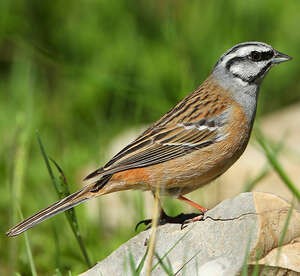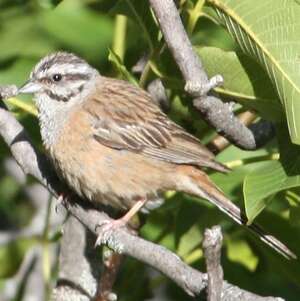Rock Bunting
Emberiza cia - Bruant fou
Identification
The Rock Bunting is a mountain bird with a typical feather pattern, reddish brown body with a grey head. Sexual dimorphism is so faint that it can sometimes be hard to tell the sex apart.
In the adult male plumage, red dominates. On the upper parts, a chamois red tone can be seen on the mantle, the upper back and scapulars as well as on the edge of the greater coverts, the inner remiges and the central rectrices. The rump and lower back are evenly reddish, invisible when the wings are closed. The mantle has clear blackish streaks. The lesser coverts are almost invisible and grey. The dark medium coverts are finished off with white outlined in black, forming a clear wing bar. A less visible second bar results from the light chamois tips of the greater coverts. The head, neck and upper chest are ash grey. The head has three longitudinal black stripes, one on the edge of the crown and descending on the nape, one at the loral and post-ocular level, over the dark eye, the last one as a moustache starting from the beak. The two last black stripes meet around the ear. This head pattern is characteristic of the species. The beak, with a straight culmen and gonys, is black on top and steel blue under. The lower parts are a uniform chamois red from the middle of the chest, with a clear edge between the grey and red. Besides the central feathers the tail is black, with a lot of white on the distal part of both outside rectrices. The legs are pale orange.
The female and the first year male are alike, but with a grey and red less vivid and slightly striated on the chest, flanks, supateurs and subcaudals.
The juvenile is rather 'non descript', that is to say dull and without any outstanding feature.The adult's head pattern is absent. It is brown striped with blackish-brown on the top and grey striped with grey-brown on the head, chest and flanks. The eye is surrounded by white and the legs are pink. It is good to know the shrill call of the species as an additional criterion. 4 subspecies are described that differ little from each other.
Subspecific information 6 subspecies
- Emberiza cia cia (c and s Europe to the Balkans and n Turkey, nw Africa)
- Emberiza cia hordei (Greece through s Turkey and south to Israel and Jordan)
- Emberiza cia prageri (the Caucasus, s Ukraine, e Turkey and sw and n Iran)
- Emberiza cia par (ne Iran to c Asia, and n Pakistan)
- Emberiza cia stracheyi (nw Himalayas to sw Tibet and Nepal)
- Emberiza cia flemingorum (c Nepal)
Foreign names
- Bruant fou,
- Escribano montesino,
- cia-ocidental,
- Zippammer,
- bajszos sármány,
- Grijze Gors,
- Zigolo muciatto,
- klippsparv,
- Klippespurv,
- strnádka cia,
- strnad viničný,
- Klippeværling,
- vuorisirkku,
- sit negre,
- Steintittlingur,
- głuszek,
- klinšu stērste,
- skalni strnad,
- Горная овсянка,
- ヒゲホオジロ,
- 灰眉岩鹀,
- klippsparv,
- 灰眉岩鵐,
Voice song and call
The usual call, a kind of tsi piercing and extremely cutting, is often what allows to detect the presence of the species. The song is a rather short, not stereotyped phrase, a small refrain resembling a Woodlark's song with some Eastern Orphean Warbler intonations. The singer is often perched in the uppermost part of a shrubby tree or a rock.
Habitat
The Rock Bunting is a heliophilic rupestrian bird of the foothill and mountainous levels. During reproduction, it appreciates the south-facing slopes of valleys and reliefs where rocky elements (cliffs, chaos and rocky scree, even piles of stone and man-made rubble) alternate with vegetated spaces allowing access to the ground (dry meadows, thermophilous scrublands and open oak and pine woods, young plantations, old terraced crops, vineyards, etc.
Behaviour character trait
The Rock Bunting has a strong connection to its mineral environment, such as pebbles, rocks, etc. Male Rock Buntings are often found perched on rocks while singing.
Rocks often provide the home for its nests. Like other buntings, Rock Buntings form small groups after reproduction. Depending on the environmental and climatic conditions, these groups remain in the same area, or migrate farther away. During colder months, Rock Buntings are known to join other seed-eating birds at winter feeding sites without difficulty.Dietfeeding habits
In the breeding season, the Rock Bunting's diet mainly consists of a variety of invertebrate prey, mostly insects and their larvae like caterpillars, but also oligochaetes, spiders, small molluscs, and of course some seeds.
Young are fed like this for the first few days, but at the end of the breeding period, adults introduce the first seeds. In the bad season, the diet changes drastically, as the resources do. The Rock Bunting becomes granivorous and there is an abundance of choices, from grass and flower's seeds taken either from the plants themselves or from the ground.Reproduction nesting
The breeding season lasts from March to August, occasionally going to mid-September. The nest is built by the female and is located on the ground, protected by vegetation and/or a rocky element.
A typical clutch consists of 3 to 5 light beige eggs with brown markings and is incubated by the female for 13-15 days. The chicks will hatch and are fed by both parents with caterpillars, insects, worms, etc. They they leave the nest after 9-13 days and become independent three weeks later. There can sometimes be a second brood, exceptionally a third one.Geographic range
The range of Rock Buntings over the eurasian continent is centered around the 40th parallel and extends from Spain and Morocco in the west to Western Mongolia in the east. All mountain ranges around the Mediterranean, Anatolia, the caucasus region and northern Iran are occupied. Further east, it can be found in the Hindukush, the Tien Chan, the Pamir, Altai and West Himalayas.
In Europe, it reaches up to the Vosges in France, the edges of the Rhine Valley in Germany and certain elevations in Austria, Slovakia and Hungary. It does not nest in Corsica.
Most of the birds from the north or high altitudes leave their territories in winter to spread out in the surrounding plains and plateaus to escape the harshness of winter and especially snow. This is how the species can be seen in the south of France, including Corsica, across Italy, the Balkans and the Middle East during this season. The same applies to the Asian mountains mentioned above.
Threats - protection
IUCN conservation status
concern
in the Wild
threatened
evaluated
Rock Bunting is not threatened according to BirdLife International criteria (large range, numerous populations). It is even shown to be in slight expansion in Europe at the turn of the centuries. The main local threat is degradation of its habitat. For example, in the Mediterranean context, accidental fires of dry forests and scrub in difficult to access places must be feared, even though the environment will eventually regenerate in the long run.
Sources of information
- IOC World Bird List (v15.1), Gill, F and D Donsker (Eds). 2025-12-07.
- Buntings and Sparrows, Byers C., Olsson U. and Curson J.
- Les passereaux d'Europe, tome 2, P. Géroudet, M. Cuisin
- Avibase, Lepage Denis
- Birds of the World, The Cornell Lab of Ornithology
- xeno-canto, Sharing bird sounds from around the world,
Other sources of interest
 Specification sheet created on
25/07/2023 by Jean François
Specification sheet created on
25/07/2023 by Jean FrançoisTranslation by AI Oiseaux.net
© 1996-2026 Oiseaux.net
- Accipitriformes
- Aegotheliformes
- Anseriformes
- Apodiformes
- Apterygiformes
- Bucerotiformes
- Caprimulgiformes
- Cariamiformes
- Casuariiformes
- Charadriiformes
- Ciconiiformes
- Coliiformes
- Columbiformes
- Coraciiformes
- Cuculiformes
- Eurypygiformes
- Falconiformes
- Galliformes
- Gaviiformes
- Gruiformes
- Leptosomiformes
- Mesitornithiformes
- Musophagiformes
- Nyctibiiformes
- Opisthocomiformes
- Otidiformes
- Passeriformes
- Pelecaniformes
- Phaethontiformes
- Phoenicopteriformes
- Piciformes
- Podargiformes
- Podicipediformes
- Procellariiformes
- Psittaciformes
- Pterocliformes
- Rheiformes
- Sphenisciformes
- Steatornithiformes
- Strigiformes
- Struthioniformes
- Suliformes
- Tinamiformes
- Trogoniformes
































